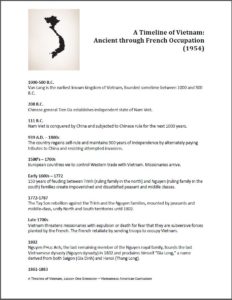The Refugee Act of 1980
Objectives
- Students will understand the varied experiences of refugees and immigrants from Vietnam during the process of immigration and resettlement through the study of photographs and interview/personal information.
- Students will understand the significance and the impact of the Refugee Act of 1980 and take a stand through a persuasive writing.
What You Will Need:
- Portrait cards of Vietnamese refugees found in the Portrait Cards section
 with teacher information and thumbnail photos in the Background Information section
with teacher information and thumbnail photos in the Background Information section
- “Vietnamese American History” information
 as needed to generate discussion (copy masters are provided if needed)
as needed to generate discussion (copy masters are provided if needed)
- Optional: “Oral Interview Sample Questions for Immigrant and Migrant Histories” student hand-out if doing the Extension Activity
Activity, Part I
Present the photograph cards to the class or have groups of students study a single photograph to then share with the rest of the class. Use your knowledge from reading “Vietnamese American History” (from Lesson One) and these questions to generate discussion and understanding of the different refugee experiences with the students:
- How is the experience of the person(s) in the photograph similar or different from the experiences of other refugees from Vietnam that you have studied so far?
- What can you tell from the photo and text that indicate how the person is adapting to life in a new country?
- Can you think of how you would feel and what your challenges would be if you were a refugee in a foreign country?
Activity, Part II
Students will “jigsaw” Refugee Act of 1980 in groups and review the significance and the impact. The Refugee Act of 1980 can be found on the U.S. Department of Health and Human Services website at http://www.acf.hhs.gov/programs/orr/policy/refact1.htm in its entirety. Or use the Library of Congress site to learn the purpose of each section of the Refugee Act at http://thomas.loc.gov/cgi-bin/bdquery/z?d096:SN00643:@@@L&summ2=m&.
The “jigsaw” is an instructional strategy for students to work in a collaborative group on a particular piece of literature. Here are the steps (adapted from www.jigsaw.org):
- Divide students into 5- or 6-person jigsaw groups. The groups should be diverse in terms of gender, ethnicity, race, religion, ability, etc.
- Appoint one student from each group as the leader and liaison to the teacher.
- Divide the literature into 5-6 segments depending on how many people are in the group.
- Assign each student to read and learn one segment, becoming an “expert” on their own segment. Give students time to read over their segment at least twice and become familiar with it. There is no need for them to memorize it.
- Form temporary “expert groups” by having one student from each jigsaw group join other students assigned to the same segment. Give students in these expert groups time to discuss the main points of their segment and to rehearse the presentation they will make to their jigsaw group.
- Bring the students back into their jigsaw groups.
- Ask each student to present her or his segment to the group. Encourage others in the group to ask questions for clarification.
Activity, Part III
The teacher will divide the class into groups of five and give each of the students one of the following statements below. Each student will then develop 3-5 talking points to explain their statement to the group as well as persuade the group that this is the position that should be taken by the group.
Five Positions on Refugees:
- Accept all refugees from Vietnam because the U.S. is a land of freedom. We have always welcomed refugees and immigrants. Almost all Americans are immigrants or ancestors of people from other countries (except for Native Americans).
- Put a quota on the number of refugees we will accept in a year. We cannot take all of them at one time. That would be too hard for America.
- Accept only the educated refugees. They will be able to help America. The uneducated refugees will be a lot of trouble. They will not be able to get jobs.
- Accept the uneducated refugees. They will take the jobs that Americans do not want to do. They will work for low pay.
- Do not accept any refugees. America already has too many problems. We have many poor and homeless and unemployed people here already. We cannot take care of more people.
Once all five students have had a chance to persuade the group of their position, the group will vote on one of the statements as their group position on refugees. This position then becomes the thesis for each student’s persuasive paper.
Assessment
Ask the students to produce a persuasive essay to support their stand on statement 1-5. What are the significant components of the Act? Why might it be important to provide resources for effective resettlement?
Teacher’s Note:
Persuasive writing, also known as the argument essay, utilizes logic and reason to show that one idea is more legitimate than another idea. It attempts to persuade a reader to adopt a certain point of view or to take a particular action. The argument must always use sound reasoning and solid evidence by stating facts, giving logical reasons, using examples, and quoting experts.
When planning a persuasive essay, follow these steps
- Choose your position. Which side of the issue or problem are you going to write about, and what solution will you offer? Know the purpose of your essay.
- Analyze your audience. Decide if your audience agrees with you, is neutral, or disagrees with your position.
- Research your topic. A persuasive essay must provide specific and convincing evidence. Often it is necessary to go beyond your own knowledge and experience. You might need to go to the library or interview people who are experts on your topic.
- Structure your essay. Figure out what evidence you will include and in what order you will present the evidence. Remember to consider your purpose, your audience, and you topic.
The following criteria are essential to produce an effective argument
- Be well informed about your topic. To add to your knowledge of a topic, read thoroughly about it, using legitimate sources. Take notes.
- Test your thesis. Your thesis, i.e., argument, must have two sides. It must be debatable. If you can write down a thesis statement directly opposing your own, you will ensure that your own argument is debatable.
- Disprove the opposing argument. Understand the opposite viewpoint of your position and then counter it by providing contrasting evidence or by finding mistakes and inconsistencies in the logic of the opposing argument.
- Support your position with evidence. Remember that your evidence must appeal to reason.
The following are different ways to support your argument:
- Facts – A powerful means of convincing, facts can come from your reading, observation, or personal experience. Note: Do not confuse facts with truths. A “truth” is an idea believed by many people, but it cannot be proven.
- Statistics – These can provide excellent support. Be sure your statistics come from responsible sources. Always cite your sources.
- Quotes – Direct quotes from leading experts that support your position are invaluable.
- Examples – Examples enhance your meaning and make your ideas concrete. They are the proof.
